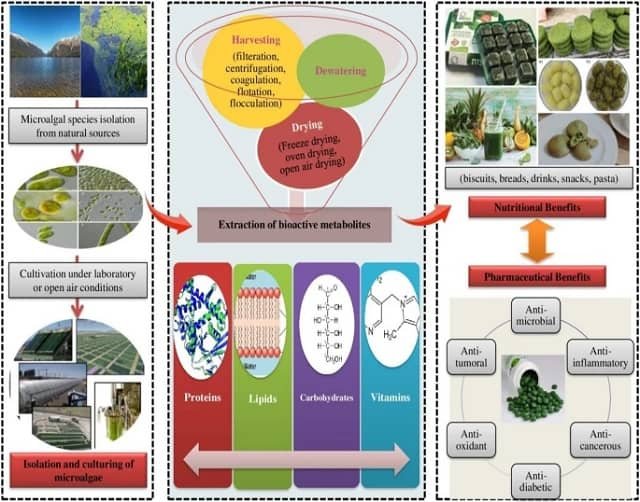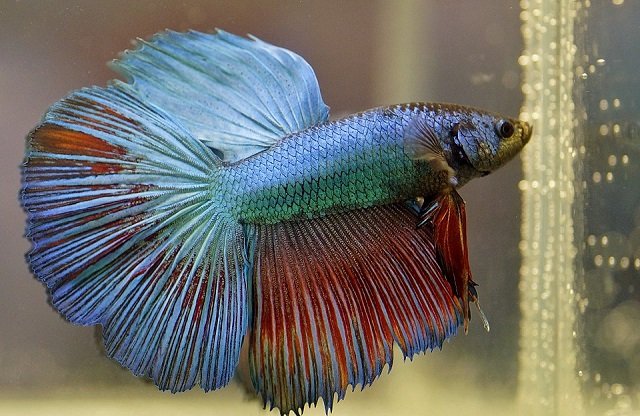
The aquaculture industry has focused on finding alternatives to fishmeal, such as plant- and animal-derived proteins, insect meals, and microbial proteins.
The main challenge is that many of these alternatives lack the bioactive compounds present in fishmeal, which are essential for fish health and growth.
A study published by scientists from Christian-Albrechts-University Kiel, the Fraunhofer Research Institution for Individualized and Cell-Based Medical Engineering, and Alex-Ekwueme Federal University Ndufu-Alike in Reviews in Aquaculture provides insights into the crucial role of bioactive compounds in fish feed and the knowledge gaps that need to be addressed to optimize their use in aquaculture.
The importance of bioactive compounds in fish feed
Bioactive compounds are natural chemical substances found in small amounts in plants, animals, and other living organisms. These compounds have biological effects on cells or organisms, influencing growth, health, and overall well-being.
In aquaculture, bioactive compounds such as trimethylamine N-oxide (TMAO), phospholipids, nucleotides, glycosaminoglycans (GAGs), betaine, creatine, collagen, and dipeptides/tripeptides play a crucial role in improving fish growth, immune response, and feed utilization.
Traditionally, fishmeal has been the primary source of these bioactive compounds in aquafeeds. Fishmeal is rich in high-quality proteins, essential amino acids, polyunsaturated fatty acids, vitamins, minerals, and bioactive compounds. However, economic and environmental constraints associated with fishmeal production have led to a shift toward alternative protein sources, such as plant-based proteins, insect meals, and microbial proteins.
Challenges of fishmeal alternatives
While these alternatives offer a sustainable solution to the overreliance on fishmeal, they often lack or are deficient in certain bioactive compounds essential for fish health and growth.
Stay Always Informed
Join our communities to instantly receive the most important news, reports, and analysis from the aquaculture industry.
For example, plant-based proteins, such as soybean and rapeseed meal, have low levels of TMAO, phospholipids, and collagen, which are abundant in fishmeal. This deficiency can lead to suboptimal growth and health outcomes in farmed fish, necessitating supplementation.
What are bioactive compounds?
Bioactive compounds are naturally occurring chemical substances found in small amounts in plants, animals, or other living organisms that exert biological effects on cells or organisms. These compounds can influence diet stability, functionality, and palatability, thus promoting fish growth and health. Additionally, they enhance nutrient absorption and digestibility by modulating gut microbiota.
Key bioactive compounds and knowledge gaps
The study by Iheanacho highlights several bioactive compounds that remain insufficiently documented in the literature, particularly regarding their effective dietary inclusion rates, species-specific requirements, and life-stage-specific effects. Below are some of the key bioactive compounds and the associated knowledge gaps:
Trimethylamine N-Oxide (TMAO)
TMAO is a non-protein nitrogenous compound found in fish that promotes growth, robustness, and feed utilization. However, its dietary inclusion rates are not well-defined, and excessive amounts may lead to adverse effects on product quality and human health.
Phospholipids
Phospholipids are essential for juvenile fish but are often overlooked in post-juvenile fish diets. While fish in the growth phase can endogenously synthesize phospholipids, supplementation may enhance growth performance. Further research is needed to determine species-specific and composition-related effects.
Nucleotides
Nucleotides, naturally present in plants and animals, are crucial for fish growth and immune function. However, there is limited knowledge about their digestion, absorption, and metabolism in fish. Optimal dosage, age-specific responses, and timing of administration remain poorly studied.
Glycosaminoglycans (GAGs)
These compounds are abundant in fishmeal and animal byproducts but absent in plant-based proteins. Their application in aquafeeds is underexplored, with limited information on dietary inclusion rates and species-specific requirements.
Betaine
Betaine, a non-essential amino acid and metabolite of choline, offers potential benefits for aquaculture species. However, standardized dietary inclusion rates are challenging to establish, and more research is needed to determine species-specific rates.
Creatine
Creatine, found in animal tissues but not in plant proteins, promotes growth in fish. However, unguided inclusion rates may lead to allergenic issues, and more information is needed on life-stage-specific requirements.
Collagen
Abundant in fish and animal byproducts, collagen is deficient in plant-based proteins. While collagen supplementation has shown promising results, adverse effects on growth have been reported, necessitating further research to determine optimal dietary inclusion rates for different fish species and life stages.
Dipeptides/tripeptides
These non-nitrogenous protein compounds, soluble in water, are exclusively found in fish flesh and animal tissues. Dietary supplementation with dipeptides in plant-based diets could improve fish growth and muscle development, but research remains limited.
Conclusion and recommendations
The study emphasizes the need for aquafeed nutritionists to expand their focus beyond the basic nutritional content of fish feed.
Bioactive compounds play a fundamental role in enhancing diet stability, functionality, and palatability, promoting fish growth and health. However, significant knowledge gaps remain regarding optimal inclusion levels, species-specific responses, and life-stage-specific effects of these compounds.
To fully leverage the potential of bioactive compounds in aquafeeds, researchers recommend prioritizing the following areas:
- Species-Specific Research: Conduct studies to determine the optimal inclusion rates of bioactive compounds for different fish species and life stages.
- Composition-Related Effects: Investigate the effects of different bioactive compound compositions, such as phospholipids, on fish growth and health.
- Standardized Protocols: Develop standardized feed formulation protocols that consider both nutritional safety and aquaculture productivity.
- Risk Management: Address potential risks associated with the excessive or improper use of bioactive compounds, such as adverse interactions and toxicity.
By addressing these knowledge gaps, the aquaculture industry can develop more efficient and sustainable feed solutions that ensure the health and growth of farmed fish while minimizing environmental impact. This will not only enhance aquaculture productivity but also contribute to global food security and sustainability goals.
Contact
Stanley Iheanacho
Institute of Animal Breeding and Husbandry, Department Marine Aquaculture, Christian-Albrechts-University Kiel
Kiel, Germany
Fraunhofer IMTE, Fraunhofer Research Institution for Individualized and Cell-Based Medical Engineering, Aquaculture and Aquatic Resources
Büsum, Germany
Department of Fisheries and Aquaculture, Alex-Ekwueme Federal University Ndufu-Alike
Achoro-Ndiagu, Nigeria
Email: stanley.iheanacho@funai.edu.ng
stanley.iheanacho@imte-extern.fraunhofer.de
Reference (open access)
Iheanacho, S., Hornburg, S. C., Schulz, C., & Kaiser, F. (2025). Knowledge Gaps Concerning Bioactive Compounds in Fish Feed. Reviews in Aquaculture, 17(2), e70009. https://doi.org/10.1111/raq.70009
Editor at the digital magazine AquaHoy. He holds a degree in Aquaculture Biology from the National University of Santa (UNS) and a Master’s degree in Science and Innovation Management from the Polytechnic University of Valencia, with postgraduate diplomas in Business Innovation and Innovation Management. He possesses extensive experience in the aquaculture and fisheries sector, having led the Fisheries Innovation Unit of the National Program for Innovation in Fisheries and Aquaculture (PNIPA). He has served as a senior consultant in technology watch, an innovation project formulator and advisor, and a lecturer at UNS. He is a member of the Peruvian College of Biologists and was recognized by the World Aquaculture Society (WAS) in 2016 for his contribution to aquaculture.




